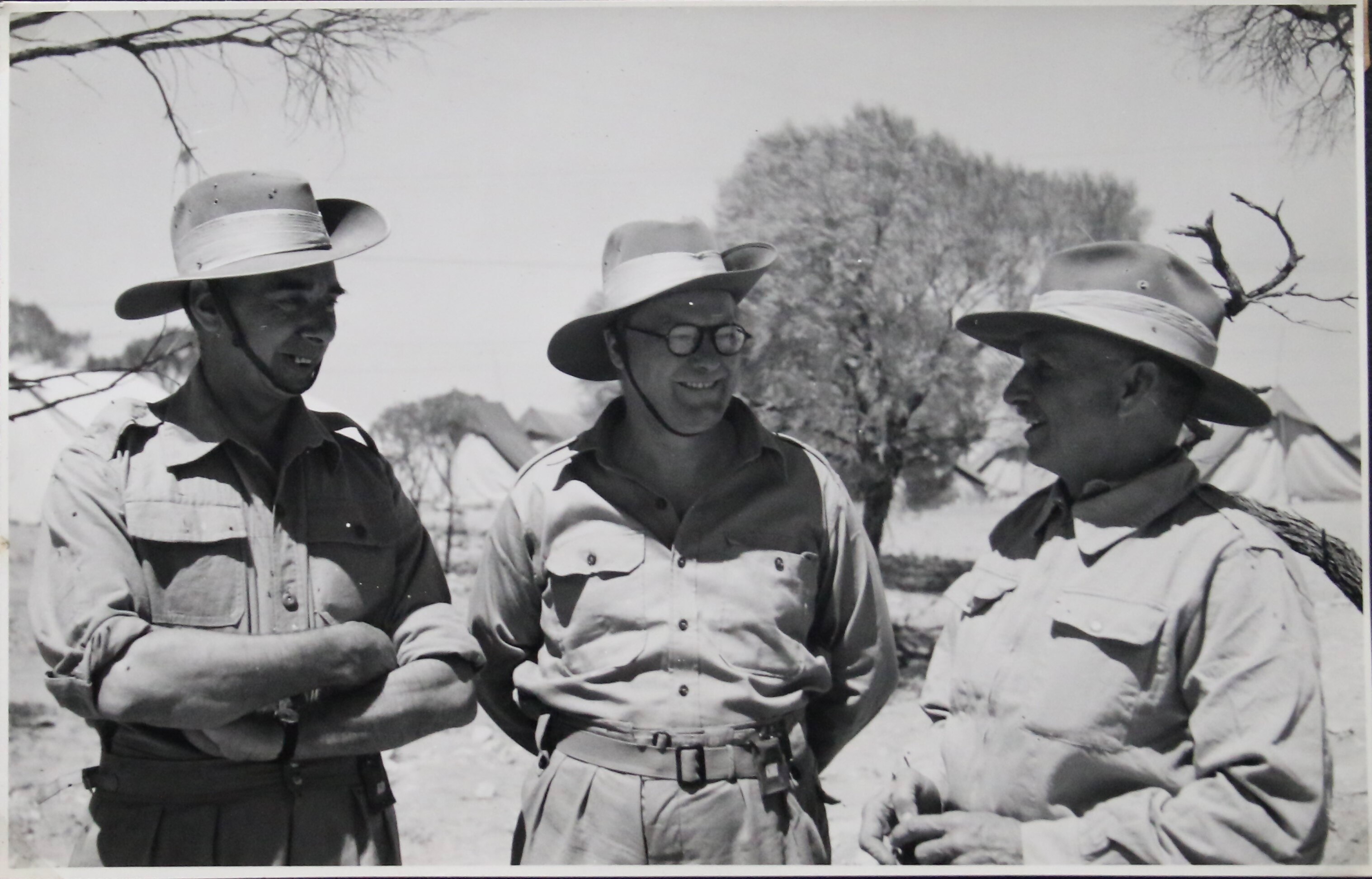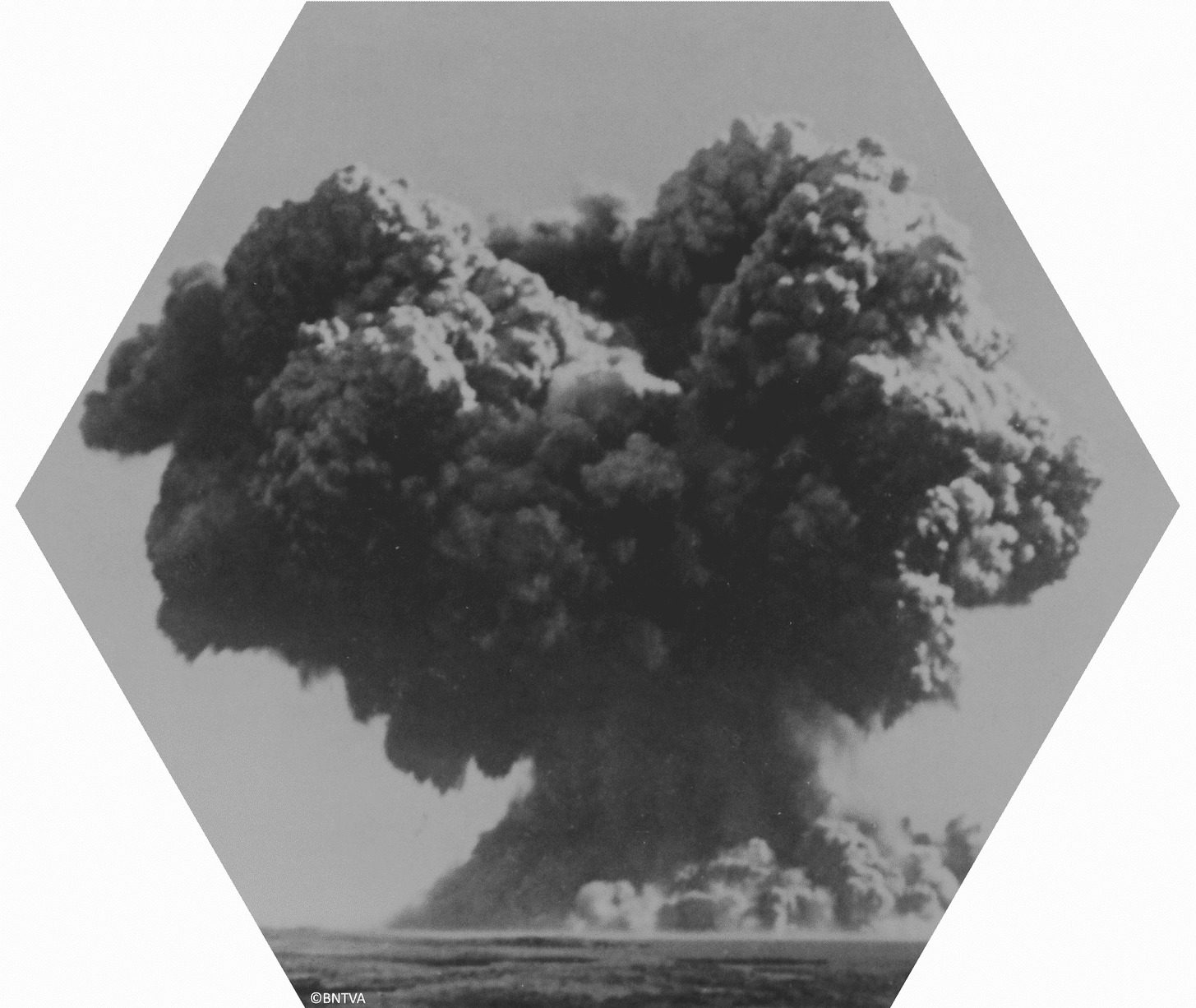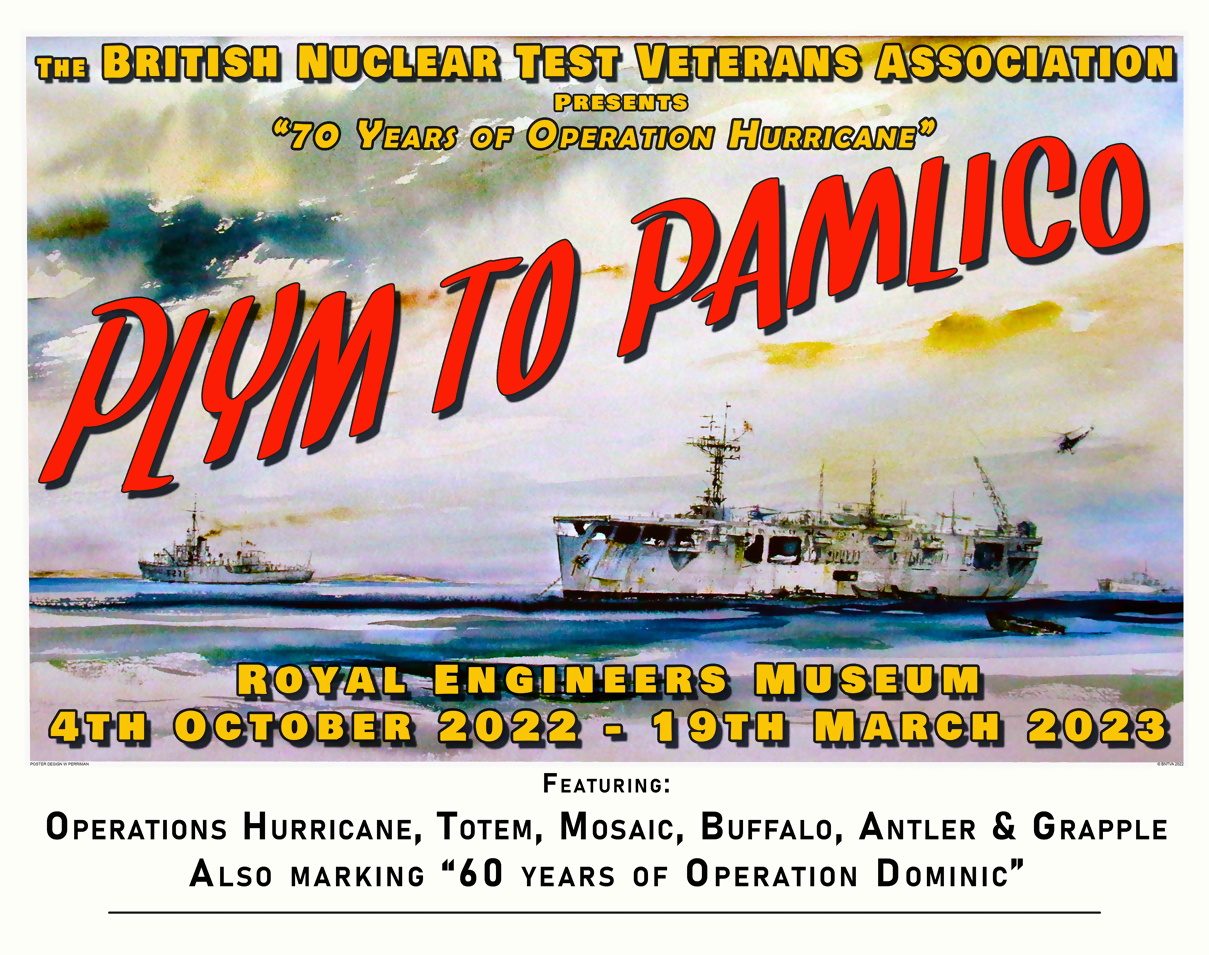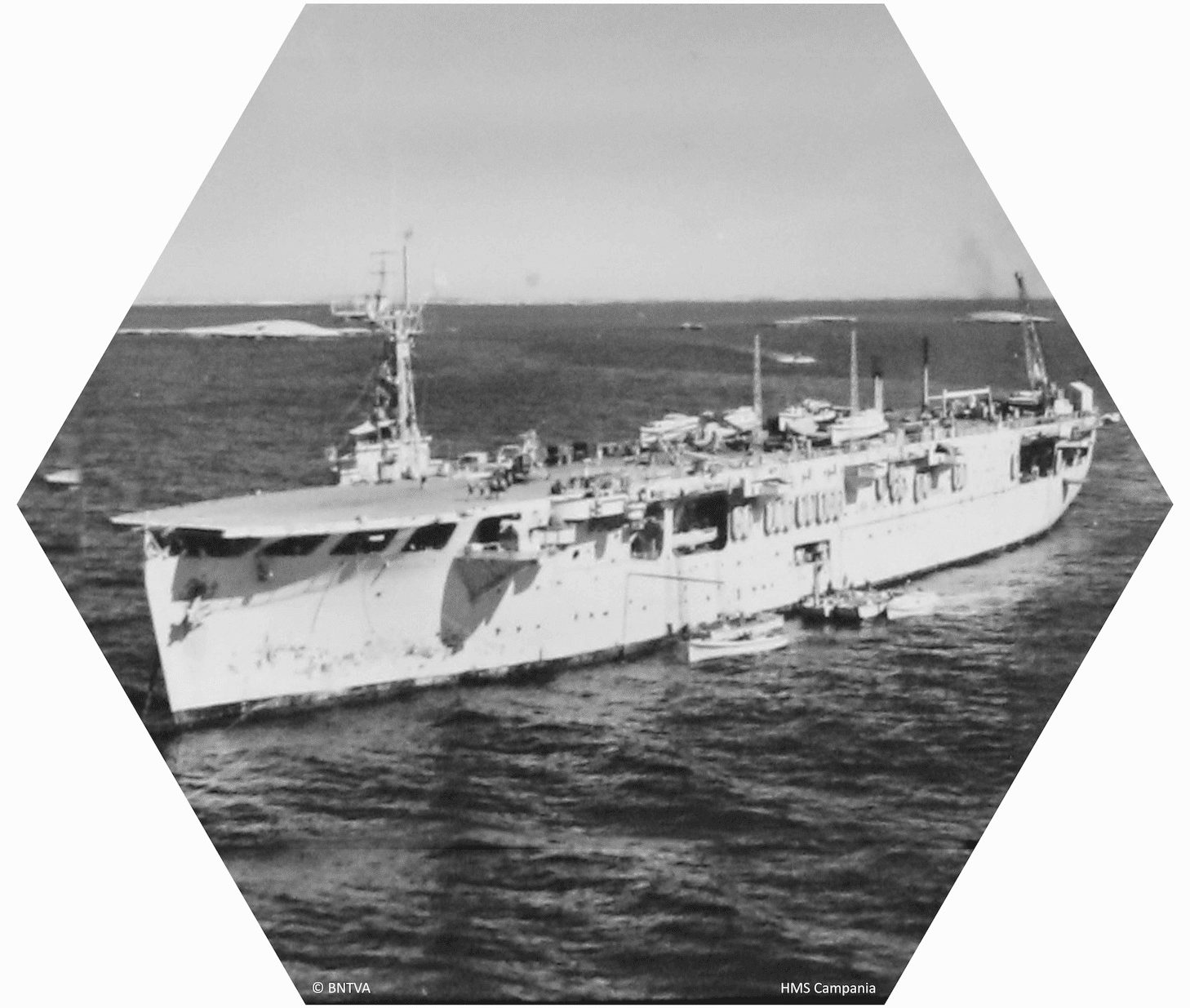
An exhibition of Britain’s nuclear bomb testing, ‘Plym to Pamlico’, will display memorabilia of Britain’s little-known nuclear bomb testing off the coast of Australia 70 years ago: Operation Hurricane.
Above: Scientist William Penney (centre) at Operation Totem
Back in June, you couldn’t move for Union Flags, street parties and national pride as everyone gathered together to celebrate the late Queen Elizabeth II’s Platinum Jubilee.
But 2022 also marks 70 years since another defining moment in British history. A much darker episode, that may pass many by. October 3rd marks the 70th anniversary of Britain’s first atomic test, codenamed Operation Hurricane, which saw the country become the third nuclear power behind the US and Russia.
During the 1950s and into the 1960s, the UK continued to show off its nuclear capabilities with further tests on mainland Australia, the Montebello Islands off the coast of Western Australia and Christmas Island in the South Pacific. Often the servicemen who witnessed these tests were not given adequate safety equipment and were exposed to high levels of radiation. Many would go on to suffer from rare cancers and disease, with their descendants also blighted by ill health.
Now a new exhibition is offering a glimpse into this forgotten period of British history, including rare and unseen photographs, artefacts from the testing programme and first hand accounts of some of the 30,000 men who were there.

The bomb cloud from a test for Operation Hurricane in 1952
Called Plym to Pamlico, the exhibition has been organised by the British Nuclear Test Veterans Association (BNTVA) and documents around 20 years of nuclear tests and radiation clean-ups, from Operation Hurricane in 1952 up to the minor and oft-forgotten trials in Maralinga in the early 1960s.
The exhibition is being curated by Wesley Perriman, whose late father was a veteran of the Maralinga tests in 1963. He died from a rare form of cancer in 1989 when Wesley was just six-years-old.
It was while doing his masters in Curation Practices at Leeds Arts University in 2018 that Wesley discovered that this era of nuclear testing was poorly represented in British museums.
He said: “I started going around some of the other museums and noticed that there’s this massive, huge gap in history. In a lot of museums, you don’t see this period, or if you do see it, you see things like the Korean War, Vietnam, other key Cold War battles going on.”
Wesley took himself on a tour of museums, including the Imperial War Museum, Royal Air Force Museum Midlands in Cosforth and The York Cold War Bunker, but said: “I was disappointed just how little there was about the social history. There’s nothing there.”
Spurred on by this apparent gap, Wesley curated a small exhibition about the British nuclear testing programme, called Over the Fence…To the Other Side of the World, at the Peace Museum in Bradford in 2019.
Wesley added: “I came to the conclusion that the way to really bring this forward was for me to become a curator for the British Nuclear Test Veterans Association itself, after doing that one freelance off the back of my masters.”
The BNTVA exhibition, which opens at the Royal Engineers Museum in Gillingham, Kent, on October 4th, will feature around 60 to 70 photographs, some of which have never been put on public display before, taken at key moments during the testing programme. Selecting the best was no mean feat as the BNTVA archive, according to Wesley, contains ‘literally thousands’ of images.

Although the photos are plentiful, the servicemen who donated them were not always the best notekeepers, with Wesley often having to refer to documents from the period in order to piece together a timeline of events and work out what or who were captured in these images.
Wesley also faced a tough task in trying to strike a balance in the photos he chose to ensure all the services – army, navy and airforce – are represented equally. This was sometimes easier said than done, for example, there are naturally far fewer pictures of seamen at the tests which took place at Emu Field, in the middle of the Australian desert.
Exhibits from the Peace Museum will also be on display at Plym to Pamlico.
Wesley said: “Our incredibly rare Operation Totem collection from 1953 was part of the Peace Museum exhibition in 2019 but I will always make a big thing of it as it’s so complete and in brilliant condition.
“I have not seen another like it, and the legacy of Totem is very significant in Australia with how it affected the aboriginals. This was the test that affected anti-nuclear and indigenous rights advocate Yami Lester and his family. Yami went blind as a result, and he was a big player in telling the aboriginal side in the McClelland Royal Commission (an inquiry by the Australian government in 1984–1985 to investigate the conduct of the British during the tests).”

HMS Campania, the aircraft carrier which took scientists to the location of Operation Hurricane, Trimouille Island of the Montebello Islands in Western Australia
Previously unseen photos of scientist William Penney, who directed scientific research at the Atomic Weapons Research Establishment which resulted in the first detonation of the British nuclear bomb, will also be on display, alongside the curious sight of Penney’s bush hat, worn on site at Australia.
Also on display for the first time are letters home from servicemen to their wives and sweethearts, plus two original ship’s bells from the HMS Campania, the aircraft carrier which took government scientists to the Hurricane testing site, and the nameboard from the HMS Plym, the ship that was purposely blown to smithereens at this inaugural test.
During his research at museums around the UK, Wesley discovered that, unlike other comparable ships, no honours board exists for HMS Campania. So he has commissioned one specially for the exhibition.
Funded by the Nuclear Community Charity Fund (NCCF), the board will carry the Campania crest and include the three battle honours it received in World War 2 and recognise the ship’s role in the 1951 Festival of Britain as well as its role in Operation Hurricane.
Wesley said: “The Festival of Britain is such a watershed moment in this country. And I thought it would go really nicely on that board as it ties into looking at the past with this hope for the future and then you have got this whole new atomic future that we’ve started to create.”
The choice of venue for the exhibition is particularly poignant as the Royal Engineers were the very first servicemen who made the journey to the first test site.
Wesley said: “They were the first people on the ground for the tests really. For Operation Hurricane the Engineers went out beforehand on HMS Zeebrugge to start putting in all the facilities on the islands. So they were the first ones there.”
Ceri McDade, CEO of the BNTVA, said: “We’re struck each time a nuclear test veteran describes their time at these chilling post WW2 tests.
“It’s our privilege to share a small proportion of this relatively concealed part of Commonwealth and US History with the general public.
“Wesley has worked very hard over the past two years to collate ephemera and demonstrate the way in which the nuclear tests left a personal lasting legacy on the lives of all who participated in live nuclear detonations during the race for the nuclear deterrent.”
Plym to Pamlico will run in the Forbes Exhibition Gallery at the Royal Engineers Museum in Gillingham, Kent, on October 4th until March 19th, 2023.


